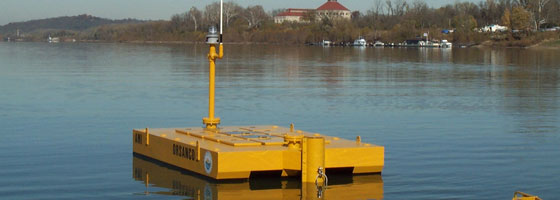Early Warning Buoy System Options

With Fondriest Environmental’s rugged and reliable early warning buoys, continuous water quality monitoring is possible. Fondriest’s early warning buoys can come equipped with multi-parameter sonde systems that house and protect several underwater sensors and powerful data logging equipment and analysis software from NexSens Technology, which are specifically designed for remote environmental monitoring applications. These systems can be configured with a wide array of sensors, data logging, telemetry, and data management options and features.
The Importance of Early Warning Systems
A river early warning system’s primary function is to alert the appropriate officials of a change in water quality or level that could cause health risks, death, injury, damage, or irrevocable harm to the surrounding ecosystem. Possible causes of contamination include accidental spills, combined sewer overflows, and both point and non-point source pollution.
A minimal system could consist of station operators using simple monitoring equipment and reporting this information via radio to a central location where the data can be combined and analyzed to assess possible problems. Real-time monitoring systems, however, can enhance or in some cases replace manual sampling. A continuous monitoring system can utilize electronic sensing, real-time telemetry, and software-generated alerts based on parameter limits to warn of impending problems as soon as they are detected. Real-time data makes it possible to respond to water quality impairments and identify contamination sources as quickly as possible.
Several spills in recent years have raised awareness for the need of such systems. On Super Bowl Sunday in 2004, about 42,000 gallons of two toxic solvents — methyl ethyl ketone and methyl isobutyl ketone — poured into the St. Clair River, forcing the closure of intakes for water plants serving tens of thousands of people in the Detroit area.
In February 2007, roughly 8,000 gallons of a petroleum-based substance called cumene spilled into the Ohio River between Illinois and Kentucky after a barge collided with a lock wall. The Ohio was contaminated yet again in 2009 when eight million gallons of raw sewage gushed from a wastewater treatment plant in Louisville, Kentucky, leaving a visible brown streak in the river.
Warning systems are a crucial component to disaster readiness in such circumstances, and they are increasingly necessary for rivers near urban areas. Many major rivers now possess early warning systems, including the St. Clair, Ohio, Potomac, Alleghany, and Monongahela rivers. Fondriest Environmental has configured and installed many of these river monitoring systems. A warning system must be capable of notifying officials and providing them with enough advanced notice to take necessary precautions. For this to happen, water conditions must be monitored, danger must be predicted, and this information must be communicated to necessary persons.
Configuration Options
Fondriest has had a great deal of experience configuring and installing early warning systems. Our monitoring systems and data loggers have been refined over the years to accommodate the specific needs of early warning system applications.
 NexSens provides a fully submersible data logger that is inserted into a buoy’s center tower. NexSens data loggers can be equipped with real-time telemetry options including radio, cellular, or satellite telemetry. The buoy also has top-side openings to place three 5-watt solar panels that power the data logger.
NexSens provides a fully submersible data logger that is inserted into a buoy’s center tower. NexSens data loggers can be equipped with real-time telemetry options including radio, cellular, or satellite telemetry. The buoy also has top-side openings to place three 5-watt solar panels that power the data logger.
On the receiving end of data logger transmissions is NexSens’ iChart data collection and processing software. It simplifies and automates many of the tasks associated with acquiring, processing, analyzing, and publishing environmental data. iChart is a complete, ready-to-use environmental data toolkit. It is designed with an open architecture and offers a straightforward interface. The software makes it easy for anyone to configure and customize early warning systems. iChart can also automatically send alerts if a water quality parameter exceeds predefined limits. Thus, if a monitoring buoy detects signs of a possible contaminant, officials can be notified immediately.
iChart software can export data directly into WQData, a secure web datacenter providing an online interface for viewing environmental data. It offers 24/7 instant access to project data using any web browser. Project datacenter sites can be password-protected or publicly accessible. Using WQData, visitors can view dynamic project area maps overlaid with data from individual early warning buoys, recent and historical data, time series graphs, statistical summaries, and project-specific information.
For additional information about Fondriest’s early warning buoys, call an application engineer at 888.426.2151 or email customercare@fondriest.com.





0 comments